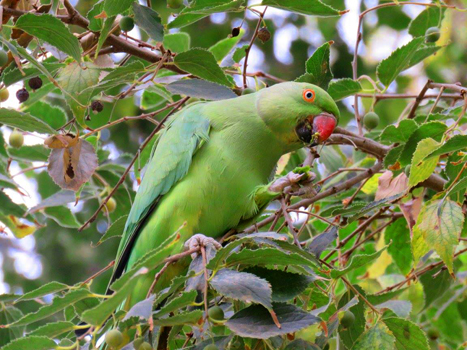Climate similarity favors biological invasion, but a match between seasonality in the novel range and the timing of life cycle events of the invader also influences the outcome of species introduction. Yet, phenology effects on invasion success have generally been neglected. Whether a phenological mismatch limits the non-native range of a globally successful invader, the Ring-necked parakeet, in Europe, was studied. Given the latitudes at which parakeets have established across Europe, they breed earlier than expected based on breeding dates from their native Asian range. Moreover, comparing the breeding dates of European populations to those of parakeets in Asia, to five native breeding bird species in Europe and to the start of the growing season of four native European trees, the discrepancy between expected and actual breeding phenology is greater in northern Europe. In these northern populations, this temporal mismatch appears to have negative effects on hatching success, and on population growth rates in years that are colder than average. Phenological mismatch also can explain why parakeets from African populations (that are more likely to breed in autumn) have been poor invaders compared to parakeets from Asia. These lines of evidence support the hypothesis that the reproductive phenology of the Ring-necked parakeet can be a limiting factor for establishment and range expansion in colder climates. Results provide growing support for the hypothesis that the match between climate seasonality and timing of reproduction (or other important life cycle events) can affect the establishment success, invasive potential and distribution range of introduced non-native species, beyond the mere effect of climate similarity. informacion[at]ebd.csic.es: Luna et al (2017) Reproductive timing as a constraint on invasion success in the Ring-necked parakeet (Psittacula krameri). Biol Invasions DOI: 10.1007/s10530-017-1436-y
https://link.springer.com/article/10.1007/s10530-017-1436-y
Welcome
Welcome to the official website of the Doñana Biological Station (EBD-CSIC)...

The Doñana Biological Station: EBD-CSIC
The Doñana Biological Station is a public Research Institute belonging to the Spanish Council for Scientific Research CSIC in the area of Natural Resources...

Mission
Our fundamental mission is to carry out multidisciplinary research of the highest standard directed to understanding the way in which biodiversity is generated, maintained and deteriorates, as well as the consequences of its loss...

Our methods
We apply many techniques within a multidisciplinary framework, from molecular genetics to remote sensing, and from modelling to physiological and isotopic analyses...

Monitoring the environment
Monitoring biodiversity at the Doñana Natural Space cover a wide range of communities, including both terrestrial and aquatic organisms...

Aims
Our aims include the study of the ecological and evolutionary processes by combining field work, mathematical and statistical models and physiological and genetic analysis...
 News
News
 Las altas temperaturas están provocando que las lagunas y las marismas de Doñana pierdan agua rápidamente
Las altas temperaturas están provocando que las lagunas y las marismas de Doñana pierdan agua rápidamente
 Traffic noise causes lifelong harm to baby birds
Traffic noise causes lifelong harm to baby birds
 Illegal wildlife trade, a serious problem for biodiversity and human health
Illegal wildlife trade, a serious problem for biodiversity and human health
 Urbanization and loss of woody vegetation are changing key traits of arthropod communities
Urbanization and loss of woody vegetation are changing key traits of arthropod communities
The loss of woody areas is linked to a decline in the duration of the activity period, a higher tolerance to drought, and less dispersal capacity in both groups.






